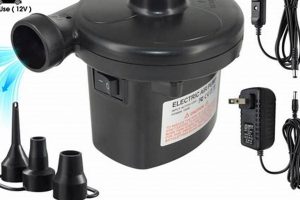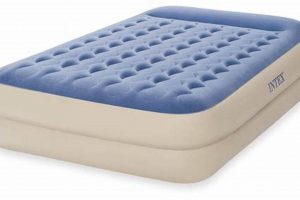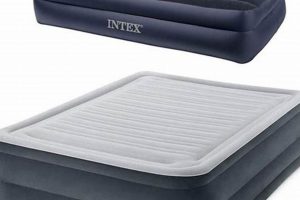An inflatable sleeping surface designed for temporary use can offer varying levels of support. The suitability of such a surface for individuals experiencing discomfort in the lumbar region depends on several factors, including construction, adjustability, and the specific nature of the back ailment. Considerations should be given to the capacity of the product to maintain spinal alignment and distribute weight evenly.
The purported value of such mattresses stems from their potential to be customized to individual comfort preferences through inflation control. The ability to modify firmness can be beneficial for those seeking pressure relief or specific support levels. Historically, these mattresses were primarily employed for camping or accommodating guests; however, advancements in design and materials have led to increased interest in their potential therapeutic applications.
The following sections will explore the key characteristics that determine the appropriateness of an inflatable sleeping surface for managing back discomfort, including material composition, internal structure, and user adjustability, and will offer insights into selecting a model that prioritizes spinal health.
Tips for Optimizing Air Mattress Use for Back Pain Relief
Selecting and utilizing an inflatable mattress effectively can potentially mitigate back discomfort. These tips offer guidance on optimizing its use.
Tip 1: Prioritize Adjustable Firmness: Opt for models with precise inflation controls. This feature enables the user to customize the level of support, accommodating varying pressure point sensitivities and spinal alignment needs.
Tip 2: Consider Internal Coil Construction: Mattresses with internal coil systems or baffled designs tend to provide more uniform support and minimize sagging, which can exacerbate back pain.
Tip 3: Evaluate Material Density: Thicker, more durable materials, such as reinforced PVC or rubber, offer greater stability and resistance to deformation, contributing to consistent support.
Tip 4: Utilize a Mattress Topper: Adding a memory foam or latex topper can enhance comfort and provide additional cushioning, further reducing pressure on sensitive areas.
Tip 5: Ensure Proper Inflation Levels: Overinflation can create an excessively firm surface, while underinflation can lead to inadequate support. Refer to the manufacturer’s instructions for optimal inflation guidelines.
Tip 6: Supplement with Supportive Bedding: Employ ergonomic pillows and supportive blankets to maintain proper spinal alignment and minimize strain on the neck and back.
Tip 7: Rotate the Mattress Regularly: Periodic rotation can distribute wear evenly and prolong the mattress’s lifespan, ensuring consistent support over time.
Adhering to these suggestions can improve the potential benefits of an inflatable mattress, promoting more comfortable and supportive rest for individuals experiencing back discomfort.
The subsequent section will address common misconceptions and concerns associated with using an inflatable mattress for managing back-related ailments.
1. Adjustable firmness
Adjustable firmness represents a critical feature when assessing the suitability of an inflatable mattress for individuals seeking relief from back pain. The capacity to modify the mattress’s internal pressure allows for personalized support, directly impacting spinal alignment and pressure distribution.
- Personalized Spinal Alignment
The ability to adjust firmness enables users to fine-tune the mattress to maintain natural spinal curvature. Overly firm surfaces can exacerbate pain by applying excessive pressure to bony prominences, while insufficiently firm surfaces may lead to spinal misalignment due to inadequate support. Modifiable firmness allows for accommodating individual anatomical variations and preferred sleeping positions.
- Targeted Pressure Relief
Adjustable firmness facilitates the optimization of pressure distribution across the body. Increased firmness can provide greater support to the lumbar region, preventing excessive sinking and maintaining spinal stability. Conversely, reduced firmness can alleviate pressure on sensitive areas, such as the hips or shoulders, minimizing discomfort and promoting circulation.
- Accommodation of Changing Needs
Individual needs may fluctuate due to factors such as weight changes, physical activity levels, or the onset of temporary conditions. Adjustable firmness provides the flexibility to adapt the mattress’s support characteristics to accommodate these evolving requirements, extending its usability and potentially mitigating the need for frequent replacements.
- Management of Specific Conditions
Certain back conditions may necessitate specific support levels. For example, individuals with herniated discs may benefit from increased firmness to stabilize the spine, while those with arthritis may prefer a softer surface to minimize joint compression. Adjustable firmness allows for tailoring the mattress to the specific requirements of diagnosed conditions, potentially contributing to symptom management.
The interplay of these facets underscores the significance of adjustable firmness in optimizing an inflatable mattress for back pain management. The capacity for personalized support, targeted pressure relief, and accommodation of changing needs contributes to enhanced comfort and potentially improved spinal health outcomes.
2. Spinal alignment
The maintenance of proper spinal alignment during sleep is a critical factor influencing back pain. An inflatable mattress’s capacity to promote or hinder spinal alignment directly determines its suitability for individuals with back ailments. When the spine is misaligned, muscles, ligaments, and intervertebral discs endure undue stress, potentially exacerbating existing pain and contributing to the development of new discomfort. Consequently, the design and features of an inflatable mattress intended for therapeutic use should prioritize the preservation of the spine’s natural curves.
The internal structure of the mattress, including coil systems or baffled air chambers, plays a significant role in providing uniform support. Inadequate support can lead to sagging in specific areas, causing the spine to deviate from its neutral position. Furthermore, the mattress’s adjustable firmness feature offers a means of tailoring support to individual needs. For instance, a side sleeper might require a slightly softer surface to accommodate shoulder and hip contours, while a back sleeper may benefit from a firmer setting to prevent excessive lumbar sinking. The interaction between these design elements and user adjustability is p
aramount for achieving optimal spinal alignment.
In summary, the ability of an inflatable mattress to facilitate proper spinal alignment is intrinsically linked to its potential for providing back pain relief. Factors such as internal structure, adjustability, and material selection contribute to the overall support provided and impact spinal health. While an inflatable mattress may offer a temporary solution, consulting with a healthcare professional remains essential for comprehensive back pain management.
3. Pressure distribution
Effective pressure distribution is a fundamental consideration when assessing the suitability of an inflatable mattress for individuals experiencing back pain. Concentrated pressure points can exacerbate discomfort, particularly in the lumbar and sacral regions. Therefore, the capacity of an inflatable mattress to evenly distribute body weight across its surface is paramount.
- Surface Area Maximization
An inflatable mattress designed for therapeutic benefit should maximize the contact area between the user’s body and the mattress surface. This minimizes localized pressure and promotes circulation. Models with internal coil systems or baffled air chambers are often better equipped to achieve this compared to simpler designs. An uneven surface can lead to pressure buildup in prominent areas, potentially aggravating back conditions.
- Adjustable Inflation and Conformity
The ability to adjust the mattress’s inflation level directly influences its conformity to the user’s body shape. A properly inflated mattress will contour to the natural curves of the spine, providing support without creating excessive pressure points. Overinflation can result in a rigid surface that fails to conform, while underinflation may lead to sagging and inadequate support. The optimal inflation level balances support and pressure relief.
- Material Properties and Cushioning
The material composition of the mattress impacts its ability to distribute pressure effectively. Thicker, more durable materials, such as reinforced PVC or rubber, can provide a more stable and supportive surface. The addition of a mattress topper, such as memory foam or latex, can further enhance pressure distribution by providing an additional layer of cushioning and conformity. The selection of appropriate materials is crucial for minimizing pressure concentrations.
- Impact on Specific Spinal Conditions
For individuals with specific spinal conditions, such as herniated discs or spinal stenosis, optimized pressure distribution is particularly important. Even distribution reduces stress on affected areas, potentially alleviating pain and promoting healing. Conversely, inadequate pressure distribution can exacerbate these conditions and impede recovery. Targeted support and pressure relief are key considerations for managing specific spinal ailments.
The facets discussed highlight the inextricable link between pressure distribution and the suitability of an inflatable mattress for back pain management. Maximizing surface area, adjusting inflation, optimizing material properties, and considering specific spinal conditions are all critical elements in achieving effective pressure distribution, ultimately contributing to improved comfort and potential therapeutic benefits. While an appropriate mattress may provide symptomatic relief, seeking guidance from a medical professional is essential for a comprehensive treatment plan.
4. Material durability
Material durability is a paramount attribute when assessing the suitability of an inflatable mattress for individuals seeking relief from back pain. The long-term structural integrity of the mattress directly influences its ability to provide consistent support and maintain proper spinal alignment over time. Deterioration of materials can lead to uneven weight distribution, sagging, and a reduction in overall support, potentially exacerbating back discomfort.
- Resistance to Punctures and Tears
The material’s resistance to punctures and tears directly impacts its longevity and ability to maintain consistent inflation. A mattress prone to leaks will require frequent reinflation, potentially disrupting sleep and compromising support. Durable materials, such as reinforced PVC or multi-layered composites, offer enhanced protection against damage from sharp objects, pets, or general wear and tear. The use of such materials ensures reliable support for an extended period, mitigating the risk of sudden deflation and associated back pain.
- Resistance to Stretching and Deformation
Prolonged use can cause some materials to stretch or deform, leading to a loss of firmness and support. This deformation can create uneven sleeping surfaces, contributing to spinal misalignment and increased pressure on sensitive areas. Durable materials with high tensile strength, such as high-density rubber or reinforced polymers, exhibit greater resistance to stretching and deformation, maintaining a consistent surface and providing reliable support over time. Choosing materials with these properties is crucial for ensuring long-term back support.
- Resistance to Environmental Factors
Exposure to environmental factors, such as temperature fluctuations and humidity, can degrade certain materials, reducing their durability and compromising their ability to provide adequate support. Materials that are resistant to these factors, such as UV-resistant polymers or waterproof coatings, offer enhanced protection against environmental damage, extending the lifespan of the mattress and maintaining its structural integrity. This is particularly important for mattresses used in outdoor settings or environments with variable climate conditions. Preserving material integrity contributes to consistent support and minimizes the risk of back pain aggravation.
- Seam Strength and Construction Quality
The strength and quality of the mattress’s seams are critical for preventing air leaks and maintaining its structural integrity. Weak or poorly constructed seams are prone to failure, leading to deflation and compromised support. Durable materials with reinforced seams and robust construction techniques, such as welded or double-stitched seams, offer enhanced protection against air leaks and ensure long-term durability. The selection of mattresses with high-quality seam construction is crucial for maintaining consistent support and preventing back pain associated with uneven sleeping surfaces.
The integration of durable materials and robust construction techniques is essential for ensuring that an inflatable mattress provides consistent, long-term support and effectively contributes to the alleviation of back pain. A mattress constructed with materials resistant to punctures, stretching, and environmental factors, combined with strong, well-constructed seams, will maintain its structural integrity over time, providing a reliable and supportive sleeping surface. This sustained support is critical for promoting spinal alignment and reducing pressure on sensitive areas, ultimately contributing to improved back health.
5. Consistent Support
The therapeutic benefit of an inflatable mattress for managing back pain hinges critically upon its capacity to deliver consistent support throughout the duration of use. Fluctuations in support levels, whether due to air leakage, material deformation, or inadequate internal structure, can undermine spinal alignment and exacerbate existing discomfort. This consistency directly impacts the efficacy of the mattress as a tool for pain management. For instance, if a mattress gradually loses air pressure during the night, the resulting change in firmness and support can lead to spinal misalignment, potentially causing or intensifying back pain. The absence of consistent support negates any potential benefits derived from adjustable firmness or material quality.
Internal coil systems and baffled air chamber designs exemplify attempts to provide more uniform and consistent support compared to simple, unstructured inflatable mattresses. These features aim to distribute weight evenly and minimize sagging, thereby preventing the development of pressure points and maintaining spinal alignment. Furthermore, the quality of the materials used in construction directly affects the mattress’s ability to retain its shape and firmness over time. Higher-density materials with greater resistance to stretching and deformation contribute to more consistent support. Consider the situation of an individual relying on an inflatable mattress as a temporary solution after spinal surgery; any inconsistency in support could impede healing and prolong recovery time.
In summary, consistent support is not merely a desirable feature, but a prerequisite for an inflatable mattress to be considered a viable option for individuals seeking back pain relief. Factors such as internal structure, material quality, and resistance to air leakage all contribute to the mattress’s ability to provide stable and reliable support over time. The challenge lies in identifying models that can effectively maintain this consistency, as fluctuations in support can negate any potential therapeutic benefits and potentially worsen back conditions. Thus, a comprehensive understanding of these elements is crucial for making informed decisions regarding the selection and use of inflatable mattresses for back pain management.
6. Ergonomic bedding
Ergonomic bedding serves as a critical adjunct to an inflatable mattress in the context of back pain management. While the mattress itself provides a supportive sleeping surface, the addition of ergonomically designed pillows, mattress toppers, and other bedding elements significantly enhances spinal alignment and pressure distribution. In the absence of appropriate bedding, even a well-constructed inflatable mattress may fail to provide adequate relief from back discomfort.
The selection of a suitable pillow is paramount. A pillow that properly supports the neck and head in relation to the spine is essential for maintaining cervical alignment. For example, a contoured memory foam pillow can provide customized support, preventing excessive strain on the neck muscles and reducing the likelihood of upper back pain. Similarly, the use of a mattress topper, such as a gel-infused memory foam layer, can further enhance pressure relief and improve overall sleep comfort. This integration of bedding elements addresses the holistic needs of the sleeper, extending beyond the core support provided by the inflatable mattress itself. Improper bedding selections, on the other hand, have the potential to negatively influence the efficacy of the inflatable mattress.
Effective utilization of ergonomic bedding, in conjunction with an appropriately selected inflatable mattress, promotes a more restful and pain-free sleep experience. Recognizing the symbiotic relationship between the mattress and its associated bedding components is crucial for individuals seeking non-invasive solutions for managing back discomfort. The overall system creates an environment that fosters spinal health, mitigating the potential for pain aggravation and promoting restorative sleep patterns. Therefore, a comprehensive approach that considers both the mattress and its bedding counterparts is essential for achieving optimal results.
Frequently Asked Questions
This section addresses common inquiries concerning the suitability of inflatable mattresses for individuals experiencing back pain, providing clear and concise answers based on established principles of spinal health and mattress design.
Question 1: Are all inflatable mattresses equally beneficial for back pain relief?
No. The suitability of an inflatable mattress depends on factors such as adjustable firmness, internal construction, and material durability. Mattresses lacking these features may not provide adequate support or spinal alignment.
Question 2: Can an inflatable mattress exacerbate existing back problems?
Yes, an inappropriate inflatable mattress can worsen back pain. Insufficient support, uneven weight distribution, or sagging can compromise spinal alignment and increase pressure on sensitive areas.
Question 3: How does adjustable firmness contribute to back pain management?
Adjustable firmness allows users to customize the mattress’s support level, accommodating individual preferences and specific needs. It enables the fine-tuning of spinal alignment and pressure distribution, potentially alleviating discomfort.
Question 4: What role does internal construction play in providing back support?
Mattresses with internal coil systems or baffled air chambers tend to offer more uniform support and minimize sagging compared to simpler designs. This structural integrity is crucial for maintaining proper spinal alignment.
Question 5: Is a mattress topper necessary when using an inflatable mattress for back pain?
While not mandatory, a mattress topper, such as memory foam or latex, can enhance comfort and provide additional cushioning, further reducing pressure on sensitive areas and improving overall spinal support.
Question 6: How often should an inflatable mattress be replaced?
The lifespan of an inflatable mattress varies depending on usage and material quality. Regular inspection for signs of wear, air leaks, or deformation is recommended. Replacement should occur when the mattress no longer provides adequate support or maintains proper inflation.
In summary, the appropriateness of an inflatable mattress for back pain management hinges upon careful consideration of its features, construction, and the specific needs of the user. Consulting with a healthcare professional is advisable for individuals with chronic or severe back conditions.
The following section will offer guidance on selecting an appropriate inflatable mattress.
Conclusion
The preceding analysis has examined the multifaceted relationship between inflatable mattresses and back pain management. The core findings underscore that the suitability of any such mattress is contingent upon a constellation of factors, encompassing adjustable firmness, internal construction, material durability, and the incorporation of ergonomic bedding. A failure to adequately address these elements may not only negate potential benefits but could, in certain circumstances, exacerbate existing spinal ailments. Therefore, the selection process necessitates a discerning approach, prioritizing models that demonstrably promote spinal alignment and consistent support.
Ultimately, the decision to utilize an inflatable mattress for back pain relief should be informed by a comprehensive understanding of its limitations and potential advantages. Individuals with persistent or severe back conditions are strongly encouraged to seek professional medical guidance to determine the most appropriate and effective course of treatment. While an inflatable mattress may offer a temporary or supplementary solution, it should not be considered a replacement for conventional medical interventions. The long-term well-being of the spine warrants a proactive and informed strategy.




![Best Coleman Air Mattress with Pump: [Year] Guide & Reviews Organic & Natural Mattress Buyer’s Guide: Non-Toxic Sleep Solutions Best Coleman Air Mattress with Pump: [Year] Guide & Reviews | Organic & Natural Mattress Buyer’s Guide: Non-Toxic Sleep Solutions](https://mattressworldpa.com/wp-content/uploads/2025/07/th-6649-300x200.jpg)


